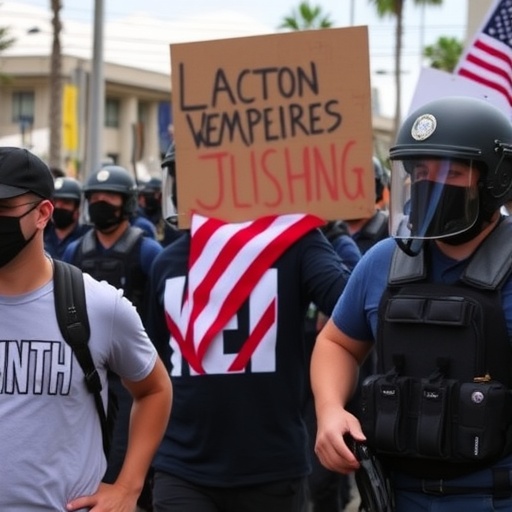ICE Tactics Escalate Aggressively as Deportations Stall and Protests Surge Across the US
In a dramatic escalation of enforcement measures, U.S. Immigration and Customs Enforcement (ICE) agents raided a bustling Los Angeles neighborhood last week, detaining over 50 undocumented immigrants in a single operation that sparked immediate outrage and street protests. This incident, one of several in recent months, highlights a concerning trend: as deportation numbers plummet to their lowest in years, ICE is turning to more forceful tactics amid mounting public protests and shifting public opinion on immigration.
- Raids Intensify in Key Cities as Deportation Targets Miss the Mark
- Nationwide Protests Ignite Over ICE’s Forceful Approach
- Shifting Public Opinion Pressures the Administration’s Immigration Stance
- Legal Battles and Internal ICE Struggles Expose Enforcement Flaws
- Future Implications: Will Escalating Tensions Force Immigration Overhaul?
Raids Intensify in Key Cities as Deportation Targets Miss the Mark
The decline in deportations has been stark. According to the latest Department of Homeland Security (DHS) data released last month, ICE removed just 142,580 individuals in fiscal year 2023, a 60% drop from the peak of over 400,000 in 2012 under the Obama administration. Factors contributing to this slowdown include overcrowded detention facilities, legal backlogs in immigration courts—now exceeding 2.8 million cases—and increased scrutiny from federal judges who have blocked several high-profile removals on humanitarian grounds.
Frustrated by these barriers, ICE has pivoted to aggressive, high-visibility operations. In Chicago, agents conducted dawn raids on construction sites, leading to the arrest of 34 workers accused of immigration violations. “We’re adapting to the realities on the ground,” ICE spokesperson Tricia McLaughlin told reporters. “Our mission is to enforce the law, and we’ll use every tool at our disposal.” Critics, however, argue that these tactics prioritize spectacle over substance, targeting low-threat individuals rather than serious criminals.
Statistics underscore the shift: While overall deportations have slowed, interior removals—those conducted away from the border—have risen by 25% in the past quarter, per ICE’s internal reports leaked to The Washington Post. This focus on urban areas, where undocumented communities are concentrated, has led to confrontations with local law enforcement, who often resist federal overreach. In New York City, for instance, NYPD officers stood by as ICE agents clashed with protesters during a raid on a Queens apartment complex, resulting in minor injuries and viral videos that amplified calls for sanctuary city policies.
Nationwide Protests Ignite Over ICE’s Forceful Approach
Public backlash has been swift and widespread. Protests against ICE tactics erupted in at least 15 major cities following the Los Angeles raid, with demonstrators chanting “Abolish ICE!” and blocking federal vehicles. In San Francisco, over 5,000 people marched to the ICE field office, leading to 200 arrests for civil disobedience. Organizers from groups like the ACLU and United We Dream described the events as a “turning point” in the immigration resistance movement.
“These raids are tearing families apart and sowing fear in our communities,” said Maria Gonzalez, executive director of the Immigrant Legal Resource Center. “ICE’s aggression isn’t making America safer—it’s eroding trust in law enforcement.” Eyewitness accounts from the Los Angeles operation paint a chaotic picture: families separated at gunpoint, children left without parents, and community leaders decrying the lack of due process. Social media footage of agents in tactical gear has gone viral, amassing millions of views and fueling hashtags like #StopICEraids.
The protests aren’t isolated incidents. A coalition of over 100 advocacy organizations has planned a national day of action for next month, coinciding with congressional hearings on immigration reform. In Denver, a sit-in at a detention center halted operations for 12 hours, drawing attention to substandard conditions inside facilities where detainees report inadequate medical care and overcrowding. These demonstrations reflect a broader wave of civil unrest, reminiscent of the 2018 family separation crisis, but amplified by today’s hyper-connected digital landscape.
Shifting Public Opinion Pressures the Administration’s Immigration Stance
Public opinion on immigration has grown increasingly polarized, with recent polls showing a majority of Americans opposing ICE’s aggressive tactics. A Gallup survey conducted in October 2023 found that 62% of respondents believe the government should prioritize pathways to citizenship over deportations, up from 54% in 2020. Among Democrats, support for ICE operations has plummeted to 28%, while even 45% of independents now view the agency unfavorably.
This shift is influencing political discourse. Democratic lawmakers, including Senate Majority Leader Chuck Schumer, have introduced the Protecting Immigrant Families Act, which aims to limit ICE’s authority in non-criminal cases and expand protections for DACA recipients. “The American people are speaking loud and clear: our immigration system needs compassion, not cruelty,” Schumer stated in a floor speech. On the Republican side, figures like House Speaker Mike Johnson defend the enforcement surge, arguing it deters illegal border crossings, which hit a record 2.4 million encounters in fiscal year 2023.
Yet, the data tells a nuanced story. A Pew Research Center analysis reveals that while concern over immigration remains high—with 68% of Americans citing it as a top issue—support for mass deportations has waned, dropping to 41% from 51% two years ago. Urban voters, particularly in swing states like Arizona and Georgia, are driving this change, influenced by personal stories of affected families shared through local media and protests. Public opinion experts note that economic factors, such as labor shortages in agriculture and construction exacerbated by deportations, are further swaying sentiments toward reform.
Legal Battles and Internal ICE Struggles Expose Enforcement Flaws
ICE’s aggressive tactics are not without consequences. Federal courts have issued at least 15 injunctions since January 2024 blocking specific operations, citing violations of the Fourth Amendment and due process rights. In one landmark case in Texas, a U.S. District Judge ruled that ICE’s use of unmarked vehicles and plainclothes agents in a raid constituted an unlawful search, awarding damages to affected families.
Internally, ICE faces turmoil. Whistleblower reports obtained by ProPublica detail low morale among agents, with turnover rates hitting 20% last year due to burnout and ethical concerns. “We’re being asked to do more with less, and it’s leading to mistakes,” one anonymous agent confided. Budget constraints play a role too: Congress allocated $8.5 billion to ICE in 2023, but much of it has gone toward detention rather than efficient removal processes, leaving field operations underfunded.
Immigration advocates are pushing for oversight reforms, including mandatory body cameras for agents and independent audits of raid planning. The Biden administration, caught between progressive demands and border security pressures, has responded with a mixed strategy: increasing legal aid for immigrants while quietly expanding ICE’s rapid response teams. White House Press Secretary Karine Jean-Pierre emphasized, “We’re committed to a humane immigration system that upholds the rule of law.” However, critics see this as too little, too late, especially as asylum seekers face prolonged waits at the border.
Future Implications: Will Escalating Tensions Force Immigration Overhaul?
As ICE’s forceful tactics collide with slowing deportations and fervent protests, the stage is set for a pivotal moment in U.S. immigration policy. Experts predict that continued public outcry could pressure Congress to revive comprehensive reform efforts, potentially including expanded work visas and streamlined deportation procedures for non-violent offenders. The upcoming midterm elections loom large, with immigration poised to be a flashpoint in battleground districts.
Looking ahead, advocacy groups are mobilizing for sustained campaigns, including voter registration drives in immigrant-heavy areas to amplify public opinion’s role. If deportation rates don’t rebound—projected to dip further to under 120,000 in 2024—ICE may face even greater scrutiny, possibly leading to leadership changes or policy pivots. For affected communities, the human cost remains immediate: families in limbo, businesses disrupted, and a nation grappling with its identity in an era of global migration.
In the words of immigration scholar Dr. Elena Ramirez from Harvard University, “This isn’t just about numbers; it’s about the soul of America. The protests and shifting opinions signal that the public is ready for change—will policymakers listen?” As tensions escalate, the path forward hinges on balancing enforcement with empathy, ensuring that immigration debates foster unity rather than division.








